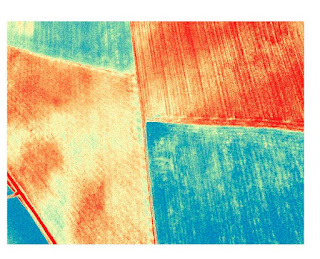Some weeks ago, we carried out a few tests with Agro Icaro Company. This is a company dedicated to precision agriculture and they take aerial pictures, and together with soil and crop samples they are able to study the vigour of plants in order to propose recommendations about localized fertilization or phytosanitary treatments
The use of aerial imagery in agriculture has been performed since the 70s, firstly using satellite imagery, then with images taken from aircraft and recently by means of drones. The improvement in the profitability has come from two sides: one by the immediacy of the data and another the cost of the image per hectare. Aerial imagery can't be standardized for all crops, because an olive is very different from a garlic, or a vine from barley. Depending on each crop you have to take the images at a certain height and you have to carry out an appropriate image processing.
The process of developing a crop vigour map has several steps:
- Plan the flight: type of crop, meteorological conditions, prohibitions, ...
- Make the flight to take the photos.
- Computer processing of all images (it is the most expensive job because it takes many hours).
The test consisted of flying about 60 hectares of various crops (cereals, garlic and pulse vegetables) to 120 metres high taking pictures with two types of camera: RGB camera (which captures the visible spectrum of light for the human eye) and NIR camera (showing a band of light near the infrared). The chlorophyllic activity of plants reflects more light in this near-infrared spectrum (and invisible to the eye). Through the cameras and mathematical calculations, we will obtain the intensity of this activity and therefore a vision of the health or vigour of our crops.
With the pictures taken, we created two crop maps (figure1: with the RGB camera and figure2: with the NIR camera). The maps are very small (their original size is approximately 14,000x21,000 pixels). This large size allows us to zoom in and see in detail the areas we need. In the first map, we clearly detect zones with different growth.
The second map is the result of treating the images with the computer applying the formula NDVI (Normalized Difference Index of Vegetation). This index is represented by a colour gradient that shows the difference in vigour of the plants, ranging from dark green (optimal growth) to red (no vegetation).
In the next map (Figure 3) we have marked several areas of interest (zones 1, 2, 3 and 4). We can clearly see that they have a very unequal growth, so we should find out the causes. First, we should go to those areas and do a visual examination (excess or lack of watering, if caused by an animal such as rabbits, wild boars, ... ). If the cause is not discovered, the best option is to do some soil and leaf analysis to know the needs of our crops.
We have marked other areas of interest (zones 5 and 6) that appear in red (if we only saw the photo, we could think that there is nothing cultivated, but in this case we know that there are grown garlic and pulse vegetables). Looking at the map RGB we see that they are cultivated, but it is seen more ground than green zone (the crop is in an initial phase of its growth), reason why to obtain an optimal results in the maps, in this type of crops it would have to fly at a lower height to be able to better capture the plants and use another type of index colour. With the same images used to create the map we have used another index (without soil features) to make the image number 4. Even when the flight height is not optimal, we can see the difference of the result with uneven growth.
Versión en español.
Video:
Pictures:




No comments:
Post a Comment